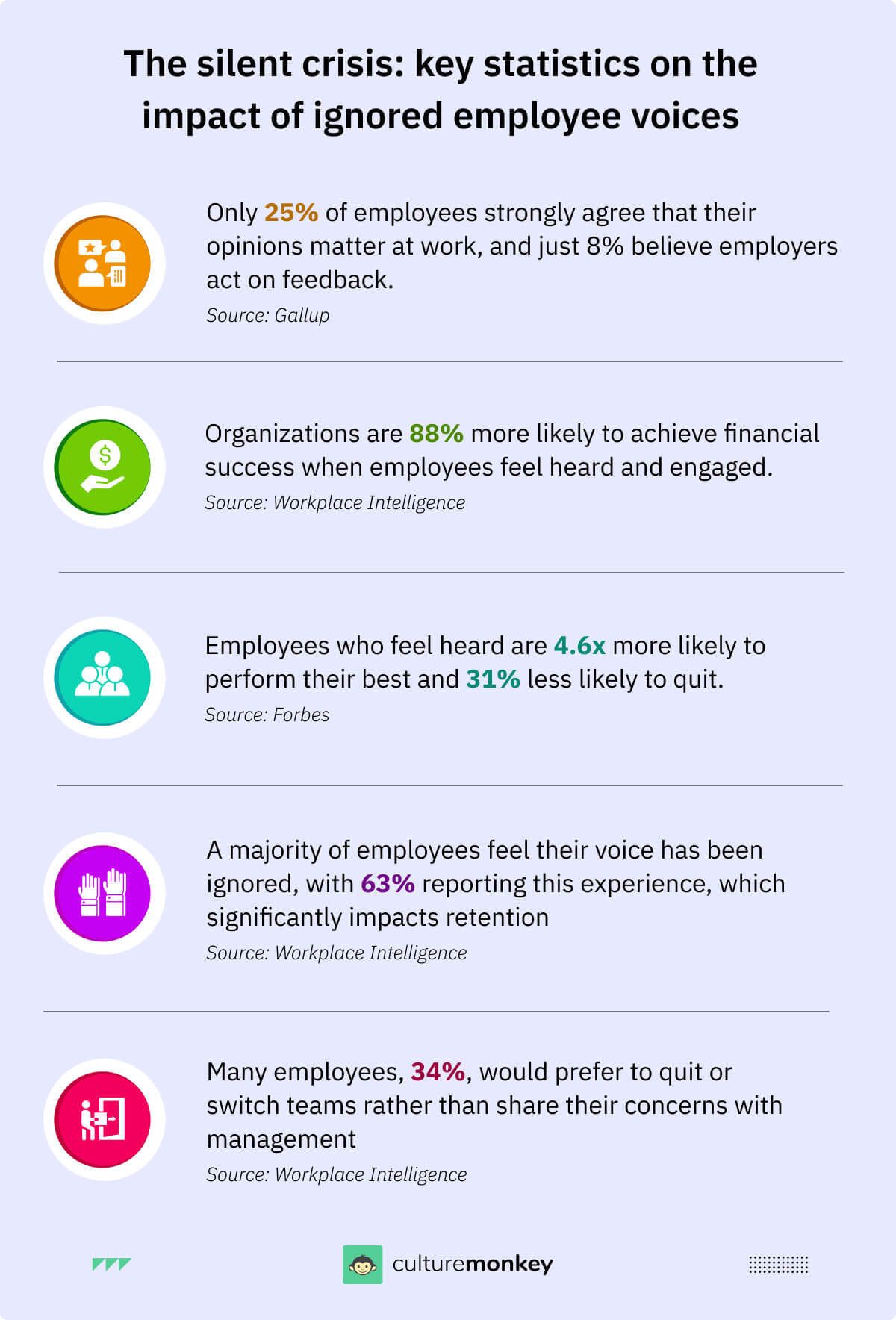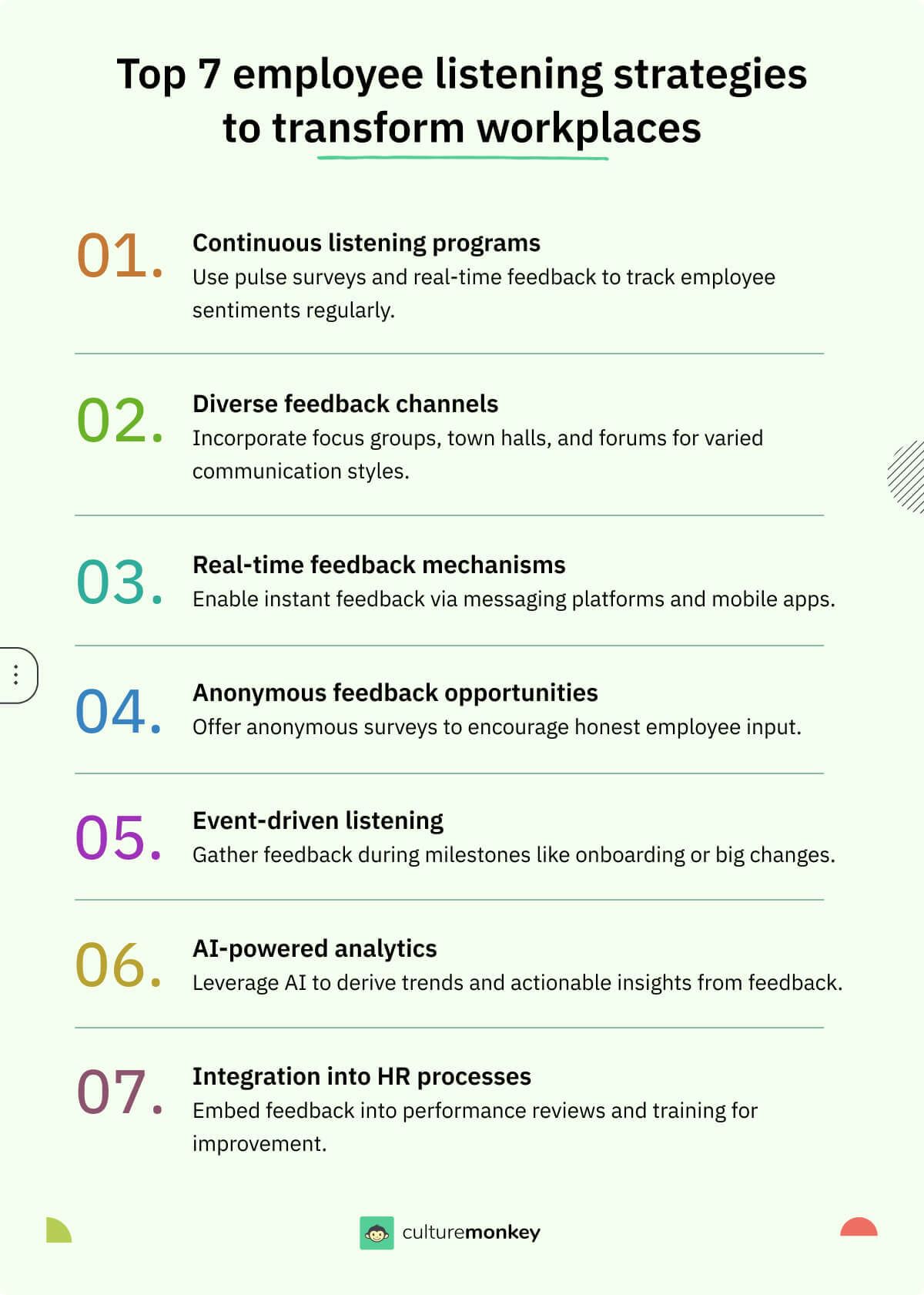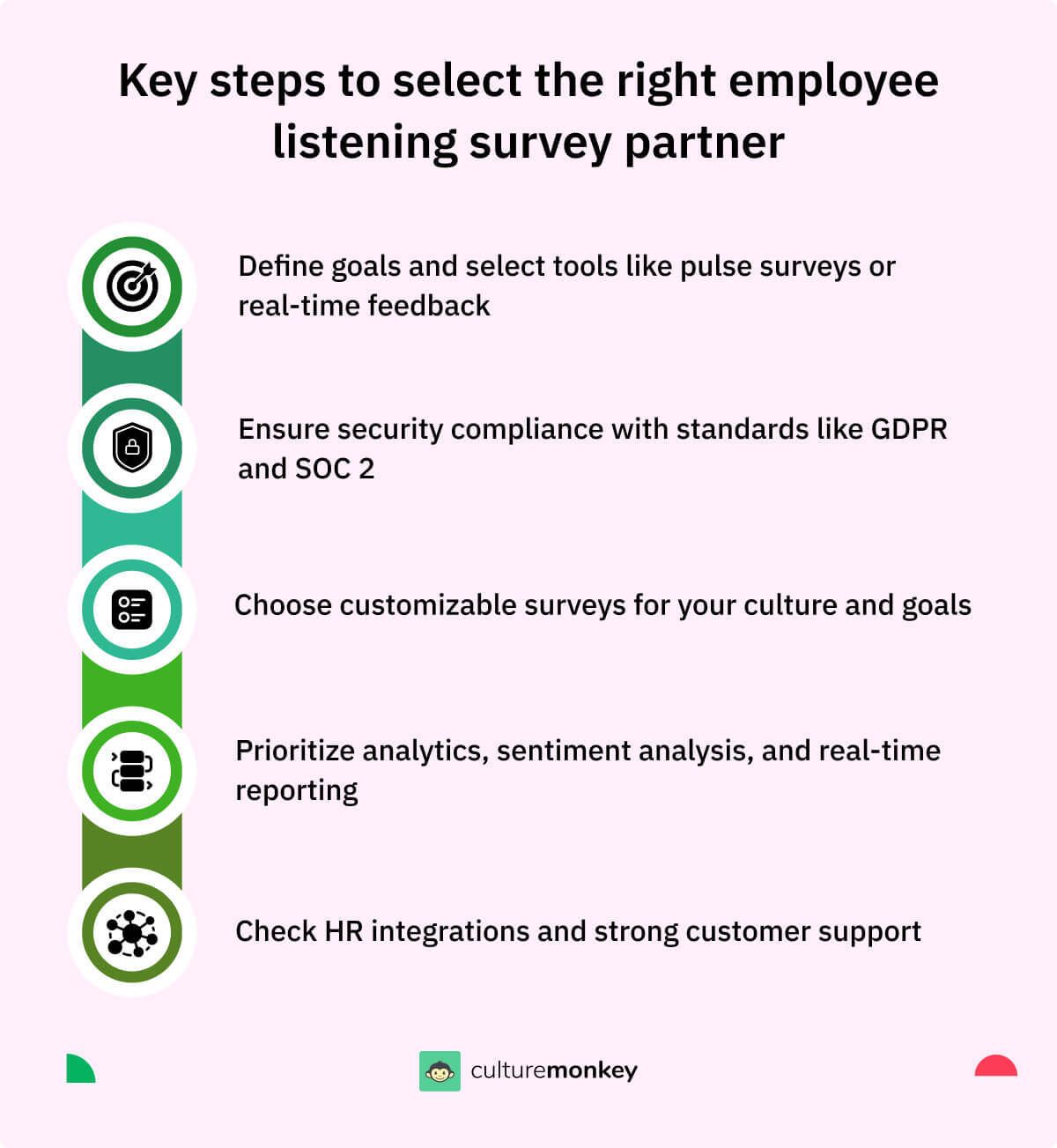What is employee listening strategy: Top KPIs to measure in 2025

Employee engagement is no longer just a buzzword; it's a business imperative. Engaged employees are more productive, innovative, and loyal, ultimately driving positive business outcomes. But how do you truly understand what engages your workforce and fosters a thriving company culture? The answer lies in employee listening.
Building a successful employee listening strategy goes beyond simply collecting feedback. It's about creating a continuous listening culture where employees feel heard, valued, and empowered. Whether you're a seasoned HR professional or just starting out, this blog post is your guide to crafting a listening program that works in 2025.
We'll delve into the top Key Performance Indicators (KPIs) to measure your listening strategy's effectiveness, explore innovative listening strategies to try this year, and provide valuable targeted insights to help you transform your workplace into one where your employees feel listened to and thrive.
Get ready to amplify your employees' voices and unlock the full potential of your workforce.
Blog Highlights


What is an employee listening strategy?

An employee listening strategy is a systematic and proactive approach employed by organizations to collect, analyze, and act upon feedback from their employees.
It involves implementing various methods such as surveys, focus groups, and continuous feedback mechanisms to gain key insights into employee sentiments, needs, and experiences. The goal is to create a workplace culture that values open communication, fosters employee engagement, and drives positive organizational outcomes.
It involves creating a continuous feedback loop, utilizing diverse methods, collecting data, and translating insights into tangible actions that contribute to a workplace culture where employees thrive and organizations flourish. We’ll go into the details below.
Significance of an employee listening model at the workplace

The significance of an employee listening model at the workplace cannot be overstated, as it plays a pivotal role in enhancing employee engagement, promoting a positive employee experience, and driving overall organizational success.
In the contemporary business landscape of 2025, where talent retention and satisfaction are paramount, implementing an effective employee listening model is imperative. Here's why -
Employee engagement and satisfaction
An employee listening model is instrumental in measuring and improving employee engagement and job satisfaction.
By actively seeking feedback through methods like surveys, focus groups, and continuous listening channels, organizations gain insights into the factors that contribute to or detract from employee engagement.
This understanding enables targeted efforts to enhance workplace conditions and address issues that may impact job satisfaction.
Positive employee experience:
A well-implemented employee listening model contributes significantly to creating a positive employee experience. Through real-time feedback mechanisms and continuous listening strategies, organizations can identify and respond promptly to concerns, fostering a workplace culture where employees feel heard and valued.
This, in turn, leads to a more positive perception of the organization, contributing to higher levels of loyalty and commitment
Driving organizational success
Employee feedback obtained through the listening model serves as a valuable resource for organizations to align their strategies with the expectations and needs of their workforce.
By analyzing survey data and qualitative insights to gather feedback, organizations can make informed decisions that positively impact business goals and outcomes.
Talent retention and recruitment
The insights gathered through an employee listening model also play a critical role in talent retention and recruitment efforts. Organizations that actively address employee concerns and continuously improve the work environment are more likely to retain top talent.
Moreover, a positive workplace reputation, fueled by a robust employee listening model, enhances the organization's attractiveness to prospective employees.

Adaptive decision-making
In the dynamic and rapidly evolving business landscape, an effective employee listening model enables organizations to make adaptive and responsive decisions.
Real-time feedback and continuous listening strategies empower business leaders to identify emerging issues, adjust strategies promptly, and stay ahead of challenges.
Creating a culture of open communication
An employee listening model contributes to fostering a culture of open communication within the organization.
Employees feel empowered to share their thoughts, knowing that their feedback is valued. This, in turn, strengthens the employer-employee relationship, contributing to a more collaborative and transparent workplace culture.
Employee listening vs. employee voice: what’s the difference?
| Aspect | Employee Listening | Employee Voice |
|---|---|---|
| Definition | Actively gathering, analyzing, and acting on employee feedback | Employees proactively expressing ideas, concerns, and suggestions |
| Focus | Collecting insights through tools like surveys and analytics | Encouraging open communication and contributions from employees |
| Purpose | Understanding employee sentiments to drive workplace improvements | Empowering employees to influence decisions and share perspectives |
| Tools and methods | Pulse surveys, focus groups, real-time feedback tools | Open forums, suggestion boxes, town halls, and 1:1 discussions |
| Outcome | Data-driven insights that inform decisions and strategies | Creating a culture where employees feel valued and heard |
| Approach | Structured and systematic feedback collection | Employee-initiated, unfiltered sharing of opinions and ideas |
How often should you listen to employees?

The frequency of listening to employees depends on the organization's culture, industry, and specific needs. In 2025, the trend is shifting towards more continuous and agile approaches, recognizing that employee feedback is valuable in real-time.
However, there is no one-size-fits-all answer for capturing feedback, and a balanced approach is key to your business strategy. Here are some considerations:
Continuous listening
- Pulse surveys: Implementing regular pulse surveys at shorter intervals, such as weekly or bi-weekly, allows organizations to capture immediate feedback on specific topics without overwhelming employees.
- Real-time feedback channels: Leveraging real-time feedback mechanisms, like suggestion boxes or instant messaging platforms, creates an environment where employees can share insights as issues arise.
- Ongoing dialogue: Encouraging ongoing dialogue through open communication channels, regular check-ins, or town hall meetings ensures that employees feel heard on a continuous basis.
Periodic surveys
- Annual engagement surveys: Conducting annual engagement surveys provides a comprehensive overview of the overall employee experience and allows organizations to track long-term trends.
- Bi-annual or quarterly surveys: Organizations might choose to conduct more in-depth surveys every six months or quarterly to delve into specific aspects of the workplace environment or address evolving concerns.
Event-driven listening
- Key milestones: Gathering feedback during key milestones, such as after a major project completion or organizational change, helps in understanding the impact on employees.
- Life cycle surveys: Implementing lifecycle surveys, at different stages of the employee life cycle, from onboarding to exit, provides insights into the evolving needs and experiences of employees.
Considerations for optimal frequency
- Response rates: Regularly assess response rates to understand how often employees are willing and able to participate in feedback activities without survey fatigue.
- Actionable insights: Ensure that the frequency allows for the collection of actionable insights, and that there is a demonstrated commitment to acting on the feedback received.
- Organizational culture: Consider the organization's culture and the speed at which decisions and changes can be implemented. More agile organizations may opt for more frequent listening.
- Balancing volume with quality: Strive for a balance between the volume of feedback collected and the quality of insights obtained. Too frequent surveys may lead to surface-level responses.
In essence, the ideal frequency of listening to employees varies, and organizations should tailor their approach to align with their goals and culture.
Striking a balance between continuous listening, periodic surveys, and event-driven feedback ensures that organizations stay attuned to the evolving needs and sentiments of their workforce in 2025.
Top 7 employee listening strategies to try in 2025

The landscape of employee listening is evolving, many organizations are demanding innovative and agile strategies to truly understand and address the needs of the workforce. Here are the top 7 employee listening strategies to consider implementing:
- Continuous listening programs: Establish a continuous listening program that goes beyond traditional annual surveys. Implement pulse surveys, real-time feedback channels, and ongoing dialogue platforms to capture immediate insights and stay attuned to the evolving sentiments of employees.
- Diverse feedback channels: Embrace a variety of feedback channels, including focus groups, town hall meetings, and open forums. This diversified approach ensures that different communication styles and preferences are accommodated, capturing a more comprehensive range of employee perspectives.
- Real-time feedback mechanisms: Leverage technology to create real-time feedback mechanisms. Instant messaging platforms, suggestion boxes, and mobile apps provide employees with the means to share their thoughts and concerns as they arise, promoting timely responsiveness.
- Anonymous feedback opportunities: Create a culture that encourages honest and open communication by providing anonymous feedback options. Anonymous online surveys or suggestion boxes help employees feel more comfortable sharing candid insights, fostering a psychologically safe environment.
- Event-driven listening: Implement event-driven listening strategies to capture feedback now, such as conducting surveys or focus groups during key organizational milestones or after significant changes. This targeted approach ensures that employee feedback is captured during critical periods.
- AI-powered analytics: Utilize artificial intelligence (AI) and advanced analytics to derive meaningful insights from large datasets. AI can analyze patterns and trends in employee feedback, providing organizations with actionable insights and helping them make data-driven decisions.
- Integrated listening into HR processes: Integrate employee listening into various HR processes, making it a fundamental aspect of talent management and organizational development. This includes incorporating feedback into performance reviews, training programs, and employee development initiatives.

Implementing these employee listening strategies in 2025 goes beyond the conventional approaches, embracing technology, agility, and a holistic understanding of employee experiences.
By actively engaging with employees through diverse channels and leveraging innovative tools, organizations can create a culture of continuous improvement and responsiveness, ultimately fostering a more engaged and satisfied workforce.
Employee listening strategy KPIs to measure

By monitoring these KPIs, organizations can gain valuable insights into the success and impact of their employee listening strategy, allowing for continuous improvement and adjustment based on real-time data and feedback.
Feedback response rates:
Gauge the effectiveness of your employee listening strategy by monitoring the percentage of employees participating in surveys, focus groups, and other feedback mechanisms. This is a crucial KPI indicating the level of engagement with the various employee listening tool or initiatives.
Actionable insights implementation:
Evaluate how effectively insights gathered from various employee feedback channels are translated into tangible actions and positive changes within the organization. This KPI measures the impact and responsiveness of the listening strategy.
Psychological safety:
Measure the extent to which employees feel psychologically safe to provide honest and open feedback. This KPI reflects the success of creating an environment where employees feel comfortable expressing their opinions without fear of negative consequences.



The way your employees feel is the way your customers will feel. And if your employees don't feel valued, neither will your customers.
Co-Founder
Quality Service Marketing
Employee success stories:
Showcase success stories resulting from the implementation of feedback, demonstrating the positive outcomes and improvements achieved through the employee listening strategy. This KPI serves as tangible evidence of the continuous listening strategy's effectiveness.
Business goals alignment:
Assess how well employee feedback aligns with and contributes to the achievement of broader business goals. This KPI ensures that the listening strategy is directly contributing to the organization's overarching objectives.
Key stakeholder satisfaction:
Collect feedback from key stakeholders, including managers, leaders, and HR, to ensure that their expectations and concerns are considered in the overall employee listening strategy. This KPI reflects the alignment of the strategy with key stakeholders' needs.
Employee engagement surveys:
Monitor the results of listening data from regular employee engagement surveys, a key KPI in understanding the overall satisfaction and commitment levels of employees. This provides a comprehensive overview of the impact of the listening strategy on the workforce.
Job satisfaction:
Assess the satisfaction levels of employees in their roles and within the organization. This KPI helps in understanding specific aspects of the workplace that contribute to or detract from job satisfaction.
Anonymous feedback:
Track the volume and nature of anonymous feedback received. This KPI provides insights into the comfort level of employees in sharing candid opinions without revealing their identity.
Survey results:
Evaluate the outcomes of various surveys, including the pulse survey and focus groups conducted as part of the employee listening strategy. This KPI measures the effectiveness of different feedback collection methods.
Continuous conversation:
Measure the frequency and quality of ongoing dialogue between employees and management. This KPI reflects the success of creating an environment where communication flows seamlessly.
HR department integration:
Assess the integration of employee listening into HR processes, ensuring that it becomes an integral part of talent management and organizational development. This KPI indicates the strategy's alignment with HR functions.
How can employee surveys help you with employee listening?

Employee surveys play a pivotal role in facilitating effective employee listening by offering a structured and comprehensive method to gather insights into various aspects of the workplace. Here's how employee surveys can enhance the employee listening process:
- Holistic understanding: Employee surveys provide a holistic understanding of employee perceptions and experiences. By covering a wide range of topics such as work environment, leadership, and job satisfaction, surveys offer a comprehensive view that goes beyond specific feedback channels.
- Identifying trends: Surveys allow organizations to identify trends and patterns in employee feedback over time. This longitudinal view helps in recognizing evolving sentiments, enabling proactive measures to address emerging issues.
- Benchmarking and comparison: Surveys enable benchmarking against industry standards or previous survey results. This comparative analysis provides valuable context, helping organizations gauge their performance and identify areas for improvement.
- Quantitative data: Surveys provide quantitative data, offering measurable insights into employee sentiments. This data-driven approach allows for statistical analysis, making it easier to identify trends, correlations, and areas requiring immediate attention.
- Structured feedback: Structured survey questions provide clarity and consistency in the feedback received. This structured approach ensures that organizations can categorize and analyze survey responses more systematically, leading to more actionable insights.
- Annual engagement survey: Conducting an annual engagement survey serves as a key listening mechanism. This annual survey also provides a yearly snapshot of overall employee engagement levels and can be used as a benchmark to track progress over time.
- Capturing employee perceptions: Surveys capture employee perceptions on various dimensions, including organizational culture, leadership effectiveness, and workplace dynamics. These perceptions contribute to a nuanced understanding of the organizational climate.
- Anonymous participation: Surveys often allow for anonymous participation, encouraging employees to express their opinions candidly without fear of repercussions. This anonymity fosters a culture of openness and contributes to more honest and authentic feedback.
- Customization for specific topics: Surveys can be customized to focus on specific topics or areas of concern, allowing organizations to address targeted issues. This flexibility ensures that the survey content aligns with current business priorities and challenges.
- Long-term strategy alignment: Employee surveys help align employee feedback with long-term organizational strategies. By incorporating questions related to strategic goals and initiatives, surveys ensure that the employee listening process contributes directly to the achievement of broader objectives.
Employee surveys serve as a structured and valuable tool in the employee listening toolkit. They provide a systematic approach to gathering feedback, offer quantitative insights, and contribute to a continuous dialogue between employees and organizations, fostering an environment where employees feel heard and valued.
Chatbot vs. employee surveys - Which is better for employee listening?

Both chatbots and employee surveys have their merits, but when it comes to collecting employee feedback and listening, employee surveys stand out as a more comprehensive and nuanced tool. Here's why employee surveys are considered a better option:
In-depth insights:
Employee surveys allow for in-depth exploration of various aspects of the workplace, covering a wide range of topics such as job satisfaction, organizational culture, and leadership effectiveness. This depth of inquiry provides a more comprehensive understanding of employee sentiments.
Structured feedback:
Surveys provide a structured format for collecting feedback, ensuring consistency in responses. This structured approach to feedback enables the organizations to categorize and analyze feedback systematically, making it easier to identify trends and areas for improvement.
Customization:
Surveys can be customized to address specific organizational needs or concerns. This flexibility allows organizations to tailor questions to align with current priorities, ensuring that the feedback collected is relevant and actionable.
Anonymous participation:
Many employee surveys offer the option for anonymous participation, encouraging employees to express their opinions candidly without fear of reprisal. This anonymity fosters a culture of openness, leading to more honest and authentic feedback.
Benchmarking:
Surveys allow organizations to benchmark their performance against industry standards or previous survey results. This comparative analysis provides valuable context, helping organizations gauge their progress and identify areas for growth.
Longitudinal analysis:
Surveys, especially when conducted periodically, enable longitudinal analysis. This long-term view helps organizations track changes in employee sentiments over time, identifying trends and ensuring continuous improvement.
Quantifiable data:
Surveys provide quantifiable data, offering measurable insights into employee perceptions. This data-driven approach facilitates statistical analysis, making it easier to identify correlations and prioritize areas for action based on the magnitude of feedback.
Employee inclusivity:
Surveys ensure inclusivity by allowing all employees, regardless of their role or schedule, to participate. This inclusivity is vital for obtaining a representative sample of perspectives, contributing to a more accurate reflection of the overall workforce sentiment.
Legal and ethical considerations:
Surveys, when designed and conducted appropriately, adhere to legal and ethical considerations surrounding employee data and privacy. This ensures that the organization maintains compliance with regulations and builds trust with employees regarding data handling.
Flexibility in question types:
Surveys support various question types, including open-ended questions, providing employees the opportunity to elaborate on their responses. This flexibility allows for a richer understanding of the nuances behind the data.
While chatbots can be useful for certain interactions, employee surveys offer a more comprehensive and structured approach to gathering feedback.
By leveraging the strengths of surveys, organizations can foster a culture of continuous improvement, track progress, and make informed decisions based on the nuanced insights provided by their workforce.
How do you frame an employee listening strategy template?

Creating an effective employee listening strategy template involves outlining the key components and steps to ensure a systematic and comprehensive approach. Here's a template to guide you in framing your employee listening strategy:
Employee listening strategy template
- Introduction: Provide an overview of the importance of employee listening and its impact on organizational success. Also outline the purpose of the employee listening strategy and its alignment with overall business goals.
- Objectives: Clearly define the specific objectives of the employee listening strategy. Align objectives with key organizational priorities, such as improving employee engagement, enhancing the employee experience, or addressing specific concerns.
- Target audience: Identify the target audience for employee listening efforts. Consider different employee segments, departments, or roles that may require specific attention.
- Channels and methods: List the various channels and methods to be employed for employee listening. Include traditional methods like surveys and focus groups, as well as modern approaches such as pulse surveys, real-time feedback mechanisms, and continuous listening programs.
- Frequency and timing: Determine the frequency and timing of employee listening activities. Consider both ongoing, continuous listening initiatives and periodic surveys to capture a holistic view of employee sentiments.
- Survey design: Outline the structure and design of employee surveys. Specify the types of questions to be included, ensuring a balanced mix of quantitative and qualitative inquiries. Consider customization based on specific organizational needs and priorities.
- Anonymous feedback: Address the option for anonymous feedback and the measures in place to ensure confidentiality. Highlight the importance of creating a safe space for employees to express their opinions openly.
- Data analysis and reporting: Detail the process for analyzing and reporting on collected data. Identify KPIs to measure the success of the employee listening strategy. Specify how insights will be translated into actionable initiatives.
- Communication plan: Develop a communication plan to inform employees about the employee listening strategy. Clearly communicate the purpose, benefits, and expected outcomes of the strategy to build trust and participation.
- Integration with HR processes: Describe how employee listening will be integrated into existing HR processes. Highlight the role of employee feedback in performance reviews, talent management, and organizational development.
- Continuous improvement: Establish mechanisms for continuous improvement of the employee listening strategy. Include regular reviews, feedback loops, and adjustments based on insights and evolving organizational needs.



A workplace where employees feel heard is a workplace where innovation and collaboration flourish.
Founder
Virgin Group
- Training and resources: Identify the resources, tools, and training required for the successful implementation of the employee listening strategy. Ensure that relevant personnel are adequately trained to manage the process effectively.
- Legal and ethical considerations: Address legal and ethical considerations related to employee data privacy and handling. Ensure compliance with relevant regulations and guidelines.
- Evaluation and feedback: Establish processes for evaluating the effectiveness of the employee listening strategy. Encourage feedback from employees on their experience with the listening initiatives.
- Conclusion: Summarize the key elements of the employee listening strategy template. Emphasize the commitment to fostering a culture of open communication and continuous improvement.
Adapt this template to suit the specific needs and nuances of your organization!
Role of AI in continuous employee listening in 2025 and beyond!

Artificial Intelligence (AI) continues to play a transformative role in continuous employee listening, reshaping how organizations understand and respond to the dynamics of the modern workplace.
AI-powered tools are instrumental in automating the collection of real-time feedback, utilizing pulse surveys, chatbots, and sentiment analysis to provide a continuous stream of insights.
Machine learning algorithms enable organizations to sift through vast amounts of data, identifying patterns, trends, and outliers in employee sentiments.
This not only streamlines the feedback process but also allows for the detection of subtle shifts in employee attitudes. AI contributes to the personalization of employee listening strategies by tailoring questions and feedback mechanisms to individual preferences, roles, and experiences, enhancing engagement and the relevance of insights.
Moreover, predictive analytics powered by AI enable organizations to anticipate potential issues and proactively address them, fostering a culture of agility, responsiveness, and continuous improvement within the workplace.
Top 3 examples of employee listening during times of change

Innovative employee listening strategies are essential during critical organizational changes to maintain engagement and trust. By tailoring approaches, organizations can ensure employees feel supported through these transitions.
- Real-time feedback during mergers and acquisitions: During mergers or acquisitions, uncertainty impacts morale. Leveraging an AI-driven employee listening platform allows real-time feedback collection and analysis. This proactive approach enables leaders to address concerns promptly and maintain trust during critical changes.
- Event-driven listening at key milestones: Event-driven listening gathers feedback during specific moments like onboarding or leadership shifts. Implementing an employee listening program helps organizations capture timely, actionable insights that improve workplace experiences.
- Listening during large-scale transformation initiatives: Organizations implementing new technologies or team restructuring use continuous listening tools like pulse surveys and focus groups. Combining quantitative and qualitative feedback ensures smoother transitions and supports employee satisfaction.
Challenges while implementing employee listening strategy

Implementing an effective employee listening strategy is critical for fostering engagement, but it comes with challenges. Here are seven key obstacles organizations face and how to address them:
- Lack of leadership buy-in: Without executive support, employee listening initiatives often lack resources and direction. Leaders must understand its value in driving business outcomes, making their involvement crucial for success in any employee listening program.
- Low participation rates: Employees may hesitate to participate in surveys or feedback mechanisms due to survey fatigue or distrust. Creating shorter, engaging employee listening surveys with transparent communication about data usage can help increase response rates.
- Inconsistent feedback collection: Ad-hoc listening efforts can lead to inconsistent insights. Establishing a continuous employee listening program ensures structured, ongoing feedback that reflects real-time sentiments.
- Data overload without action: Collecting large volumes of data without taking tangible action diminishes trust. Prioritize actionable insights using an employee listening platform and communicate how feedback translates into workplace improvements.
- Addressing anonymous feedback concerns: While anonymity encourages honesty, it can make it difficult to address specific issues. Balance anonymous and direct feedback channels to ensure employees feel heard while enabling targeted resolutions.
- Technological barriers: Using outdated or incompatible tools can hinder feedback collection. Leveraging advanced employee listening tools, such as AI-driven platforms, simplifies processes and enhances analysis.
- Failure to communicate results: If employees don’t see outcomes from their input, participation declines. Share results regularly, highlight changes made, and demonstrate a robust employee listening strategy framework to build trust.
How to choose the right employee listening survey partner?

Choosing the right employee listening provider is essential for achieving meaningful insights and fostering engagement. Here are six steps to guide your decision:
- Understand your organization’s needs: Begin by identifying your goals, such as improving engagement, reducing turnover, or enhancing satisfaction. Determine if you need continuous listening tools like pulse surveys or real-time feedback solutions to address specific challenges.
- Evaluate data security and compliance: Ensure the employee listening platform adheres to high-security standards like GDPR and SOC 2 compliance. Protecting employee data is critical for maintaining trust.
- Look for customization and flexibility: The right partner should offer customizable employee listening surveys tailored to your culture and goals. This flexibility allows relevant feedback collection from diverse teams.
- Assess analytics and reporting capabilities: Choose a provider that offers advanced analytics, sentiment analysis, and real-time reporting. Such features help organizations derive insights from their employee listening program and make data-driven decisions.
- Check for seamless integrations: Ensure the provider integrates with existing HR systems like HRIS platforms, Slack, or Teams. This improves accessibility, supporting a smoother employee listening strategy implementation.
- Evaluate customer support and expertise: A strong partner provides guidance on how to build a successful employee listening strategy, including survey design, data interpretation, and action planning.
Conclusion
An effective employee listening strategy is no longer optional—it’s essential for fostering a culture where employees feel heard and valued. By implementing continuous listening, leveraging tools for real-time insights, and acting on feedback, organizations can drive engagement, retention, and productivity.
With CultureMonkey, businesses can elevate their listening programs. Its AI-powered platform for real-time feedback, in-depth analytics to uncover trends, multilingual surveys to connect global teams, and actionable insights that drive change help businesses transform feedback into meaningful action.
Empower your organization to listen smarter, respond faster, and build a thriving workplace- start with CultureMonkey today!
Summary
An employee listening strategy is a systematic approach to gathering and acting on employee feedback, fostering engagement, and driving business success. Key elements include continuous listening, actionable insights, and addressing challenges like low participation and survey fatigue.Using tools such as AI, real-time feedback mechanisms, and anonymous surveys, organizations can effectively gather insights to build a culture where employees feel heard and valued.
FAQ
1) What is an example of a listening strategy?
An example of a listening strategy is implementing pulse surveys with real-time feedback tools. Organizations use this approach as part of a continuous listening program to gather insights regularly, ensuring employees feel heard. Paired with open communication channels, it fosters trust and addresses concerns proactively. Over time, this strategy helps leaders track trends and measure the effectiveness of workplace initiatives.
2) What are the six strategies for active listening?
The six strategies for active listening include paying full attention, avoiding interruptions, asking clarifying questions, paraphrasing for understanding, providing non-verbal cues, and summarizing feedback. Organizations that measure and implement these steps create a more responsive employee listening strategy and improve communication effectiveness. Active listening not only resolves misunderstandings but also builds stronger relationships between employees and management.
3) How to build an employee listening strategy?
To build a successful employee listening strategy, identify goals, implement tools like surveys and real-time feedback, analyze insights, act on feedback, and communicate outcomes transparently. Align the employee listening program with business objectives to foster engagement and responsiveness across all organizational levels. Consistently reviewing and improving the strategy ensures it adapts to changing workforce needs.
4) What are the barriers to successful employee listening?
Barriers include lack of leadership buy-in, survey fatigue, and inconsistent feedback collection. Using an employee listening platform addresses these issues through structured processes, ensuring actionable insights and a strong employee listening strategy framework. Additionally, promoting transparency and acting on feedback builds trust, reducing skepticism among employees.
5) How often should I send employee surveys?
Organizations should balance frequency based on goals. Weekly pulse surveys are ideal for continuous listening, while annual surveys provide in-depth insights. Tailoring survey frequency ensures effective feedback collection without overwhelming employees, supporting a sustainable employee listening program. Regularly monitoring response rates ensures surveys remain engaging and effective in gathering actionable insights.
6) How can organizations ensure employee anonymity when listening to feedback?
Organizations ensure anonymity by using employee listening tools with encrypted platforms and aggregated reporting. Avoiding identifiable questions builds trust in the process. Reinforcing confidentiality policies in internal communications reassures employees about anonymity. Regularly demonstrating how anonymous feedback drives meaningful changes strengthens trust and encourages more honest and candid responses from employees.




